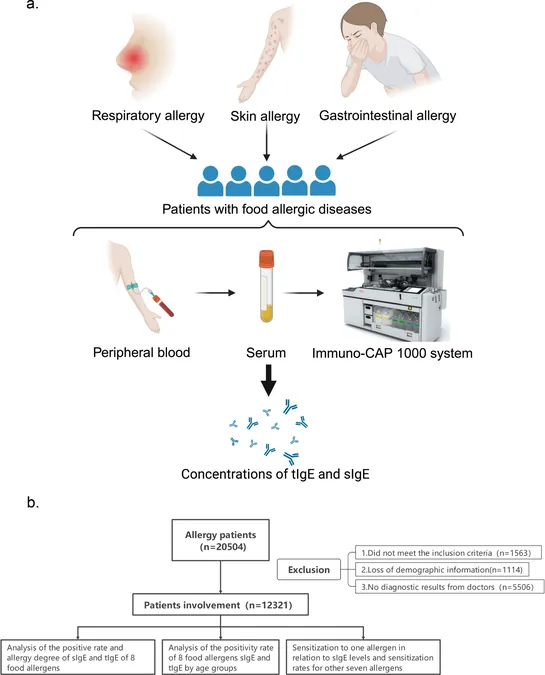
Unraveling Food Allergies in Southern China: Trends, Mechanisms, and Prevention from 2004 to 2023
2024-10-31
Author: Jia
Introduction: A Growing Concern
Food allergies are becoming increasingly prevalent across the globe, with Southern China no exception. A recent comprehensive study encompassing data from 2004 to 2023 sheds light on the epidemiological trends of total and specific IgE levels among individuals diagnosed with food allergies, emphasizing the urgent need for improved preventive measures and management strategies.
Study Overview and Methodology
In this groundbreaking research, 20,504 serum specimens were meticulously analyzed, gathered from patients seeking medical help for food allergies at the First Affiliated Hospital of Guangzhou Medical University. The targeted demographic comprised 12,321 patients undergoing serum allergen-IgE testing, revealing reactivity to various food allergens, including milk, egg white, shrimp, and crab.
The diagnostic process involved meticulous assessment of patients' clinical histories and symptomatology validated by serum-specific IgE (sIgE) positivity. To uphold the study's integrity, researchers excluded 8,183 patients undergoing allergen immunotherapy or with specific medical conditions that could skew results. By implementing a robust exclusion criteria, the analytical outcomes were untainted by potential confounding factors.
Significant Findings: A Deep Dive into Allergic Patterns
The statistical analyses highlighted alarming patterns in IgE levels, showcasing a striking 100% positivity rate for sIgE among those exposed to key food allergens. Notably, sIgE responses to milk, egg white, shrimp, and crab were the most pronounced. It came as no surprise that milk allergy prevalence peaked in infants, particularly around the age of two, while egg white sensitivity reached its zenith between three to five years of age.
As individuals aged, the data revealed a fluctuating landscape of food allergies. Surprisingly, allergies to seafood, especially shrimp and crab, surged post-adolescence. Contrarily, the tendency toward milk and egg white allergies appeared to diminish with age—reflecting a trend of acquired tolerance over time.
Co-sensitization and Its Implications
Further investigation illustrated fascinating co-sensitization trends among allergens. For instance, a staggering 82.6% of patients allergic to crab also displayed reactivity to shrimp. Furthermore, common allergens like sesame, peanuts, and soy exhibited considerable co-sensitization rates with wheat. Such patterns illuminate the intricate interconnections between various food allergies, signaling a pressing need for tailored allergen testing.
Regional Dietary Influences on Food Allergies
The study not only cataloged trends but also provided an enlightening context regarding dietary habits in Southern China. The predominant consumption of shrimp and crab in local diets may contribute to the region's high sensitization levels. The overlap of seafood allergies and prevalent respiratory allergen sources, such as dust mites and cockroaches, was also evident, suggesting that environmental factors play a crucial role in the landscape of food allergies.
Prevention and Future Directions
As food allergies continue to pose significant health risks, insights from this study could drive the development of enhanced prevention strategies. Emphasizing early monitoring and intervention during infancy and early childhood could foster acquired tolerance in susceptible populations. Furthermore, continuous research initiatives that deepen the understanding of food allergy mechanisms and underlying genetic predispositions may offer new avenues for prevention and targeted therapies.
Conclusion: A Call to Action
The compelling findings from this extensive study illuminate an urgent public health narrative: food allergies are on the rise in Southern China, with profound implications for future healthcare strategies. By harnessing this data to bolster public awareness and refine clinical practices, we can chart a path toward better management of food allergies—ultimately promoting healthier lives long into the future.
This research serves as a reminder of the need for vigilance, education, and proactive measures in the face of the growing food allergy epidemic that affects individuals of all ages.



 Brasil (PT)
Brasil (PT)
 Canada (EN)
Canada (EN)
 Chile (ES)
Chile (ES)
 Česko (CS)
Česko (CS)
 대한민국 (KO)
대한민국 (KO)
 España (ES)
España (ES)
 France (FR)
France (FR)
 Hong Kong (EN)
Hong Kong (EN)
 Italia (IT)
Italia (IT)
 日本 (JA)
日本 (JA)
 Magyarország (HU)
Magyarország (HU)
 Norge (NO)
Norge (NO)
 Polska (PL)
Polska (PL)
 Schweiz (DE)
Schweiz (DE)
 Singapore (EN)
Singapore (EN)
 Sverige (SV)
Sverige (SV)
 Suomi (FI)
Suomi (FI)
 Türkiye (TR)
Türkiye (TR)
 الإمارات العربية المتحدة (AR)
الإمارات العربية المتحدة (AR)